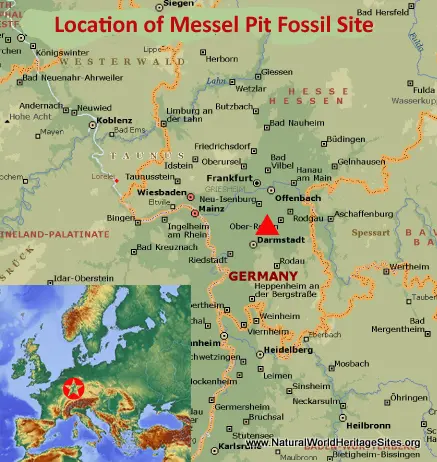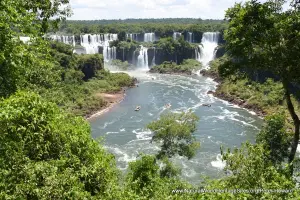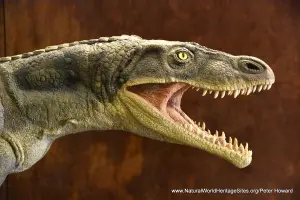EXPLORE the Messel Pit Fossil Site with this slideshow, check the location map and get all the facts and information below.
For slideshow description see right or scroll down (mobile). Click to view slideshow
Location and Values: The Messel Pit Fossil Site is located about 30 km south of Frankfurt, near the German town of Darmstadt. It was an old oil shale mine where remarkable fossil discoveries have been made. It is now recognized as the single best fossil site in the world covering the middle Eocene (47-48 million years ago), the period when the first modern mammals were evolving. In particular the site has yielded some exceptionally well-preserved mammal fossils that not only include fully articulated skeletons, but also perfectly preserved skin, hair and stomach contents. Important scientific discoveries have been made on the evolution of echolocation through detailed examination of around 600 exceptionally well-preserved fossil bats, while the discovery of about 60 skeletons of an early ‘horse’ (Eurohippus messelensis) and an early primate (Darwinius masillae) has contributed to our understanding of evolution in these important groups of mammals. Well-preserved fossils of over 1000 species of plants, birds, reptiles, insects and other animals has allowed a detailed understanding of the living environment of the Eocene.
Conservation Status and Prospects. According to IUCN’s Conservation Outlook Assessment (2017) the conservation status of the Messel Pit Fossil Site is ‘good’. The IUCN report notes that the World Heritage values of the site are well maintained with suitable arrangements for protection and management. Although much material has been removed from the site during a century of mining activity, the remaining volume of fossil-bearing oil shale sediments is massive and present scientific work is having no significant impact on preservation of the site’s potential to yield further important discoveries.
Links:
Google Earth
UNESCO Official Website
IUCN Conservation Outlook
UNEP-WCMC Site Description
Slideshow description
The slideshow ‘tells the story’ of the Messel Pit Fossil Site with a portfolio of photos by Peter Howard from a visit in June 2019. They start at the impressive visitor centre, where there is a series of exhibition rooms explaining the origins of the site, the special conditions that allowed fossils to be preserved in such exceptional detail, its mining history, the scientific discoveries arising from examination of the site’s fossils, and specimens/reproductions of some of the key fossils discovered here.
Messel Pit originated in ancient times as a maar volcano, with a very deep lake in its crater. The deep waters were calm and the lack of circulation meant that the bottom of the lake was depleted of oxygen, so the normal processes of decomposition did not occur. When an animal fell into the water and sank to the bottom, instead of decomposing it was slowly covered in layers of dead unicellular blue-green algae that flourished near the surface of the lake. Over the millennia this resulted in layer upon layer of deposits which eventually became the deep oil shale that fills the site of the old volcanic crater today.
The slideshow features some of the fossil exhibits in the visitor including a fish, bats, several ‘early horses’ (Eurohippus messelensis), a crocodilian, a turtle, a primate (Darwinius masillae), a lizard and a bird’s feather. These illustrate the diversity and quality of the exceptional fossils discovered at the Messel Pit.
Access to the quarry pit is only allowed as part of a guided tour. I was privileged to enjoy an individual tour, and the last part of the slideshow covers this part of the visit. There is a viewing platform with exhibition panels in an elevated location on the edge of the quarry from where visitors can get an idea of the scale of the mining operation that took place here. Descending into the ‘crater’ visitors are able to view the small excavation site where scientists cut ‘vertical slices’ of shale for detailed examination. The shale extracted here is moist and delicate, and any fossils that are discovered have to be kept in water to maintain them in the short term. Near the scientists’ area of operation the guided tour includes an opportunity to examine some ‘fresh’ fossil finds, including small fish and shiny insects, as well as a life-size model of the site’s renowned ‘early horse’, and a poster display of the site’s most remarkable early primate.
Factfile
Website Categories: Fossil Record;
Area: 0.4 km2
Inscribed: 1995
Criteria:
- Fossil record (viii);





